
The Pratt & Whitney Canada PW100 aircraft engine family is a series of 1,800 to 5,000 shaft horsepower turboprops manufactured by Pratt & Whitney Canada. Pratt & Whitney Canada dominates the turboprops market with 89% of the turboprop regional airliner installed base in 2016, leading GE Aviation and Allison Engine Company.
The Soloviev D-25V is a Soviet gas-turbine turboshaft engine for use in large helicopters. Designed and originally manufactured by the Soloviev Design Bureau the engine has been in production since May 1960. The power unit consists of two engines coupled to a gearbox weighing 3,200 kg (7,050 lb).
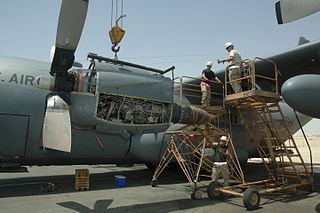
The Allison T56 is an American single-shaft, modular design military turboprop with a 14-stage axial flow compressor driven by a four-stage turbine. It was originally developed by the Allison Engine Company for the Lockheed C-130 Hercules transport entering production in 1954. It has been a Rolls-Royce product since 1995 when Allison was acquired by Rolls-Royce. The commercial version is designated 501-D. Over 18,000 engines have been produced since 1954, logging over 200 million flying hours.

The Garrett TFE731 is a family of geared turbofan engines commonly used on business jet aircraft. Garrett AiResearch originally designed and built the engine, which due to mergers was later produced by AlliedSignal and now Honeywell Aerospace.

The General Electric T700 and CT7 are a family of turboshaft and turboprop engines in the 1,500–3,000 shp (1,100–2,200 kW) class.
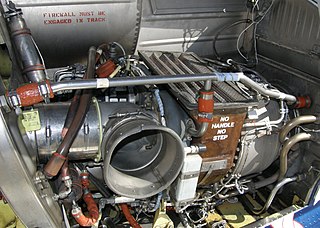
The LycomingLTS101 is a turboshaft engine family ranging from 650 to 850 shaft horsepower, used in a number of popular helicopters, and, as the LTP101 turboprop, light aircraft. Both models carry the US military designation T702. The engine was originally designed at the Lycoming Turbine Engine Division in Stratford, Connecticut, but is now produced by Honeywell Aerospace.
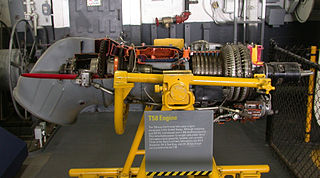
The General Electric T58 is an American turboshaft engine developed for helicopter use. First run in 1955, it remained in production until 1984, by which time some 6,300 units had been built. On July 1, 1959, it became the first turbine engine to gain FAA certification for civil helicopter use. The engine was license-built and further developed by de Havilland in the UK as the Gnome, in the West Germany by Klöckner-Humboldt-Deutz, and also manufactured by Alfa Romeo and the IHI Corporation.

The General Electric T64 is a free-turbine turboshaft engine that was originally developed for use on helicopters, but which was later used on fixed-wing aircraft as well. General Electric introduced the engine in 1964. The original engine design included technical innovations such as corrosion resistant and high-temperature coatings. The engine features a high overall pressure ratio, yielding a low specific fuel consumption for its time. Although the compressor is all-axial, like the earlier General Electric T58, the power turbine shaft is coaxial with the HP shaft and delivers power to the front of the engine, not rearwards. Fourteen compressor stages are required to deliver the required overall pressure ratio. Compressor handling is facilitated by 4 rows of variable stators. Unlike the T58, the power turbine has 2 stages.
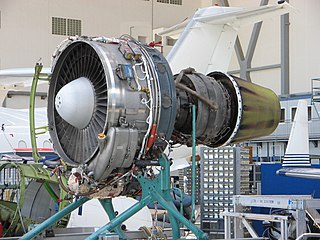
The Lycoming ALF 502/LF 507 is a geared turbofan engine produced by Lycoming Engines, AlliedSignal, and then Honeywell Aerospace. The U.S. military designation for the ALF 502 is YF102.

The Honeywell T55 is a turboshaft engine used on American helicopters and fixed-wing aircraft since the 1950s, and in unlimited hydroplanes since the 1980s. As of 2021, more than 6,000 of these engines have been built. It is produced by Honeywell Aerospace, a division of Honeywell based in Phoenix, Arizona, and was originally designed by the Turbine Engine Division of Lycoming Engines in Stratford, Connecticut, as a scaled-up version of the smaller Lycoming T53. The T55 serves as the engine on several major applications including the CH-47-Chinook, the Bell 309, and the Piper PA-48 Enforcer. The T55 also serves as the core of the Lycoming ALF 502 turbofan. Since the T55 was first developed, progressive increases in airflow, overall pressure ratio, and turbine inlet temperature have more than tripled the power output of the engine.

The Pratt & Whitney Canada PT6T Twin-Pac is a turboshaft engine designed for helicopters. Manufactured by Pratt & Whitney Canada, its first application was in the Bell 212 and UH-1N Twin Huey helicopter family. The PT6T Twin-Pac consists of two PT6A power turbines driving a common output reduction gearbox, producing up to 2,000 hp at 6,000 rpm. The engine is designated T400 by the U.S. military.
The Honeywell HTS900 is an American turboshaft engine produced by Honeywell Aerospace. A growth version of the LTS101 which it is designed to replace, the HTS900 is in the 1,000 shp (745 kW) class.
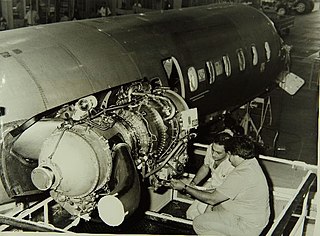
The Garrett TPF351 is a turboprop engine designed by Garrett Engine Division of AlliedSignal Aerospace Company. Initiated by Garrett in October 1987, the TPF351-20 engine was selected by Embraer to power the Embraer/FMA CBA 123 Vector, a high-speed commuter "pusher" aircraft. It was first tested on May 19, 1989 and then ground tested and flight tested on a Boeing 720 on July 9, 1990. The first prototype CBA 123 was tested on July 18, 1990, followed by a flight to the Farnborough Air Show in September of the same year. Both programs were cancelled in 1992, when the TPF351 was nine months from engine certification.

The Boeing T50 was a small turboshaft engine produced by Boeing. It was the first turboshaft engine to ever power a helicopter: a modified Kaman K-225 in 1951. Based on Boeing's earlier Model 500 gas generator, the T50's main application was in the QH-50 DASH helicopter drone of the 1950s. An up-rated version designated Model 550 was developed to power the QH-50D and was given the military designation T50-BO-12.
The Boeing T60 was a family of small turboshaft/turboprop engines produced by Boeing, based on Boeing's earlier Model 500 gas generator and Model 502 (T50) turboshaft engines.

The Continental CAE T51 was a small turboshaft engine produced by Continental Aviation and Engineering (CAE) under license from Turbomeca. A development of the Artouste, it was followed by three additional turboshaft engines, the T72, the T65, and the T67. However, none of these engines, including the T51, entered full production. CAE abandoned turboshaft development in 1967 after the XT67 lost to the Pratt & Whitney Canada PT6T (T400) to power the Bell UH-1N Twin Huey.

The Improved Turbine Engine Program (ITEP), formerly the Advanced Affordable Turbine Engine (AATE) program, is a United States Army project to develop a General Electric T700 replacement for the UH-60 Black Hawk and AH-64 Apache, improving fuel consumption, power, durability and cost. Honeywell and Pratt & Whitney formed the ATEC joint venture to develop the T900, while GE Aviation builds the T901. In February 2019, the US Army selected the GE T901 as the winner of the program.

The Klimov TV2-117 is a Soviet gas-turbine turboshaft engine intended for helicopter use. Designed in the early 1960s by the Isotov Design Bureau the engine became the first purpose built gas turbine engine for helicopter use by the Soviet Union with previous helicopter turbines being adapted aeroplane powerplants. It was later produced by Klimov, production ending in 1997.
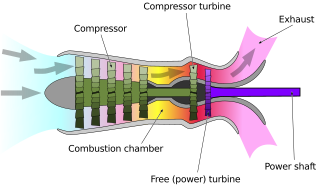
A free-turbine turboshaft is a form of turboshaft or turboprop gas turbine engine where the power is extracted from the exhaust stream of a gas turbine by an independent turbine, downstream of the gas turbine. The power turbine is not mechanically connected to the turbines that drive the compressors, hence the term "free", referring to the independence of the power output shaft. This is opposed to the power being extracted from the turbine/compressor shaft via a gearbox.

The Lotarev D-136 is a turboshaft engine from the ZMKB Progress Design Bureau. The engine powers the Mil Mi-26 "Halo" helicopter. Development of the engine had begun in about 1972.. The D-136 first flew on a production Mi-26 helicopter in 1980.

















